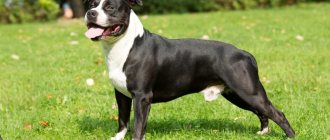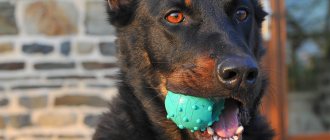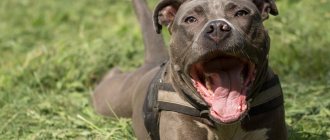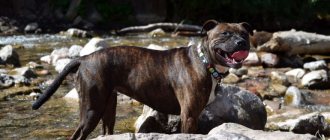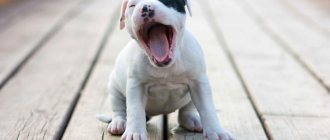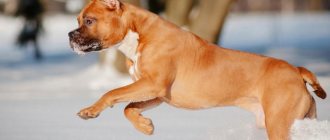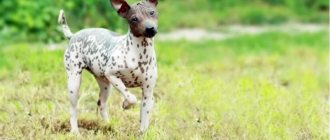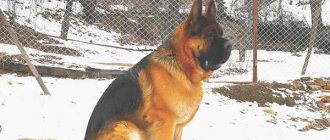- Pets
- >>
- Dog breeds
* Here is a photo of a typical representative of the American Staffordshire Terrier dog breed . You can send us photos of your animals by email, and we will post them on the website. Don't forget to send your pet's name.
Video
* We invite you to watch a video about the American Staffordshire Terrier . In fact, in front of you is a playlist in which you can select and watch any of 20 videos about a given dog breed by simply clicking on the button in the upper right corner of the window. In addition, the material contains quite a lot of photos. By looking at them you can find out what the American Staffordshire Terrier looks like.
In this article:
|
How to choose a puppy
They buy a puppy when it reaches two months of age. Such a baby can already cope without his mother, he can easily withstand moving and adapt to a new place without any problems. When choosing the gender of a dog, remember that “girls” are more affectionate and obedient , and become more attached to their family. Problems can only be associated with regular estrus and changes in the bitch's behavior during this period.
“Boys” are distinguished by their stubbornness , desire to take a leading position in the house and constantly mark their territory.
What to look for when choosing a puppy:
- eyes should be clean, round, with a dark iris, without signs of souring;
- choose a puppy with clean skin, without pustules or ulcers;
- with a rounded muzzle;
- scissor bite;
- shiny coat, without bald spots;
- clean ears, without any unpleasant odor.
The appearance of watery eyes, discharge from the ears or nose, bloating, poor appetite, and indifference indicate the presence of the disease.
Puppy cost
If you decide to get an American Staffordshire Terrier puppy, go to a certified kennel - only there you will find a purebred and healthy individual . Don't forget to find out about the dog's vaccinations, documents and pedigree. The cost varies from 9,000 to 66,000 rubles. The price is influenced by the status of the parents and the city where the purchase is made (in Moscow the price is 2 times higher than, for example, in Khabarovsk).
Before getting an American Staffordshire Terrier, think about the responsibility that falls on your shoulders. This active and powerful dog is not suitable for a homebody, an insecure, unbalanced person. Carefully weigh all the nuances , consult with a specialist, attend classes with a dog handler. And only then make a decision. A properly raised dog in good hands will become a wonderful friend and protector for your family.
History of the origin of American Staffordshire Terriers
Back in the Middle Ages, when hunting was not so much entertainment as a necessity, people needed a fast and aggressive dog with a death grip. Such a dog must both crawl into animal holes and attack large game - bears and wild boars. The mastiffs and bulldogs that existed at that time were slow and clumsy, which is why they were injured and died.
From mastiffs and bulldogs, they began to select only the most nimble puppies. Thus began the development of the ideal fighting dog: the size decreased, mobility increased, but the fighting qualities remained. Crossing bulldogs with terriers gave rise to the bull and terrier breed.
The American Staffordshire Terrier breed originates from the Pit Bull breed. Pit bulls were formed as a breed back in 1880. Pit bulls were ideal dogs for fighting and guarding, as they combined fighting and guarding qualities, and were also quite agile. Pit bulls were originally bred exclusively for fighting. Then they were distinguished by large jaws and large size.
Fun Fact: In 1936, the American Kennel Club proposed renaming the Pit Bull breed the Staffordshire Terrier. To be more precise, the breed was divided into two branches - the pit bull terrier and the Staffordshire terrier. This is how two whole branches of dog breeds appeared, which are still developing today.
In 1972, the word “American” was added to the name of the Staffordshire Terrier breed, and they were popularly called Yankee Terriers. In 1972, this breed was officially recognized by the FCI.
Advantages and disadvantages
Advantages of the breed:
- quick learner and well-developed intelligence;
- loyalty and devotion to the owner;
- reliable protection and security of the owner;
- good nature towards other animals;
- unquestioning execution of commands with good training.
Despite its advantages, Staffords have some disadvantages:
- the risk of developing aggression in character in the absence of proper education;
- intolerance of loneliness and long separation from the owner.
American Staffordshire Terrier - description of the breed
The American Staffordshire Terrier has a strong build and good growth. Typically, the height at the withers of males varies from 45 to 51 cm, and females are approximately 43-46 cm. The weight of males and females can reach 40 kg, although females, as a rule, weigh less.
Amstafs have a strong build and well-developed muscles. Despite its medium size, it gives the impression of a massive, but at the same time very compact dog. The chest of the Amstaff is deep and wide, the paws are spread in different directions, with the hind legs slightly laid back. The head is very large, with a wide transition from the forehead to the muzzle.
Amstaff ears are set high and can be either erect or semi-erect. Previously, it was customary to crop the ears of amstafs, but now this is not encouraged in canine practices. The eyes of these dogs are set wide and deep. They are small, but with pronounced brow ridges. The muzzle has no folds, the cheekbones are pronounced. Amstaff teeth are white and strong, with a scissor bite.
The bridge of the nose of dogs of this breed is rounded, the nose itself is black. The neck is short and very thick, shaped like a cone. Chest with distinct ribs, tight, tight belly. The tail is set low, short, tapering towards the end. It is not customary to dock the tail.
Among dogs of this breed there are characteristic defects that are not recognized by the breed. These include light eyes or a pink nose, pink eyelids, an overly long tail, ears that are too floppy, or an undershot jaw.
Despite its overall massiveness, the dog often looks smiling. This is caused by the peculiar structure of the jaw: it is very wide, the corners of the mouth are drawn back to the cheekbones. A smile is visible when the dog breathes through its mouth. In other cases, amstafs look impressive and stern.
Breed characteristics
| Short description | |
| Origin: | USA |
| Conditions of detention: | In an apartment, private house |
| Purpose: | Service dogs |
| Color: | Black, white and black combination, blue, brindle |
| Wool length: | Short |
| Adult dog size: | Height of females - 44-46 cm, males - 46-48 cm, weight of males - 35-40 kg, females - 25-32 kg |
| Average life expectancy: | 12-15 years |
| Walk: | 2-4 times a day |
| Physical activity needs: | Medium (walks from 1.5 to 3 hours a day) |
| Fédération Cynologique Internationale (FIC) classification: | Group 3: Terriers, Section 3: Bull – Terrier type |
| Puppy price: | $200-1300 (depending on class) |
Popular colors of American Staffordshire Terriers
Amstafs have a variety of colors, and almost all varieties are recognized by canine associations. The only undesirable colors are partially black and white dogs (up to 80 percent of the body), as well as black and tan, sand and brown.
Recognized and popular ones include the following:
- Completely black Staffordshire Terrier without spots with brown eyes;
- The blue color of Amstaff is a gradient from light gray to dark gray. The nose is also gray, the eyes are no lighter than the body color, a combination with a white chest and paws is possible;
- The red color of the amstaf is evenly distributed throughout the body;
- Red with a coating - the top layer of fur is darker than the undercoat, the coating is also clearly visible on the tail and throughout the body;
- The fawn color of the Amstaf is a combination of light red wool with a white or gray coating. Lips, nose and eyes should also be dark;
- The brindle color is one of the rarest, in which the red body is covered with black brindle stripes;
- Blue brindle - stripes on the red color of the dog are gray, the nose is black.
It is worth noting that not all American Staffordshire Terriers born from breeding parents will strictly comply with color standards. For example, dogs are often born with blue eyes, sometimes they have noses of a different color, although otherwise they fully comply with the breed standards.
Any color, even not recognized by canine associations, looks very noble on American Staffordshire Terriers. All this is thanks to the short but smooth coat. With proper care, this coat shines in the sun and shimmers like gloss. The colors have a silver or golden hue in the sun, making the dog look very beautiful.
Photos with examples of colors
The coat of Amstaffs can have different colors, but the most common are the following:
- black - a rich coal-black shade of fur, which even in the light does not have other shades, the presence of small spots in the area of the nose and paws is acceptable;
- black and white – the coat color combines white and black, if white markings are located on the face, neck, back and paws, the color is called “Boston black”;
- blue – the shade varies from light blue to bluish-black; in dogs with a rich blue color, the color of the lobe matches the shade of the coat; if the color is dark, the lobe is almost black;
- brindle - the color of the coat can be brindle or reddish; there are individuals with a rich and even color, with a red or red tint.
In accordance with the standard, any solid color, as well as particolor and spotted, are considered acceptable. White color can occupy a maximum of 80% of the body.
Solid white, black and tan, and liver colors are undesirable, but the AKC standard still allows a pure white coat color for Amstaffs.
Character and habits of American Staffordshire Terriers
Contrary to popular belief, Amstaffs are not killer dogs that are ready to attack all people and tear even their owners to pieces. This opinion about dogs existed back in the last century, when puppies were purposefully bred for dog fighting. The breed has long been no longer bred for the purpose of violent clashes, but has become a family companion. Accordingly, the aggressive qualities of Amstaff were eradicated.
Amstafs are energetic, active and reliable dogs. They are completely fearless and absolutely devoted to their owners. Since among the fighting dogs those that behaved aggressively towards people were immediately rejected, the breed gets along well with humans and behaves docilely.
American Staffordshire Terriers are very calm and courageous dogs. They are tolerant of other dog breeds, even if they begin to provoke them into aggression. With proper upbringing, Amstafs will not make any movements without the owner's permission.
In addition, Amstafs are very smart dogs. Initially, they had to think through tactics for attacking the wild animals they were hunting. Intelligence was then applied to fighting other dogs, and now we have a rational and intelligent breed. They are able to make their own decisions, which makes them excellent guards and wonderful companions.
Amstafs are very attached to their owners. This can be either one person or a family - Amstapha should not be resold as an adult, since he will never get along with other people, and then, in a stressful situation due to the absence of owners, he can become aggressive.
Amstafs are well suited for playing with children - they love children and even act as nannies. It is important that a dog of this breed goes to a good family with experienced owners, since the individual characteristics of dogs require a competent approach to them.
Differences from the English Staffordshire Bull Terrier
Representatives of these breeds share common ancestors, so their similarities are absolutely not surprising.
However, there are significant differences between them:
- Amstaffs come from America, and Staffbulls were bred in England;
- English Staffordshire Terriers are more compact dogs, they are lower at the withers and weigh less;
- Amstaffs do not get along with other pets, the “English” are more tolerant and get along with animals that grew up with them.
Also, the breed standard suggests that the ears of Amstaffs can have a natural length and shape or be cropped, while for Staffbulls cropping is not carried out.
Interesting facts about American Staffordshire Terriers
The history of this breed goes back more than two centuries, and Staffordshire Terriers do not lose their popularity among different segments of the population. They were in demand from the very beginning as fighting dogs, and are still in demand today as companion dogs for active people.
Staffordshire Terriers serve in various government rescue services. For example, it was Amstaff who was able to determine where the terrorists’ explosives were located after the terrorist attack at the Theater Center on Dubrovka. These dogs have a hard work ethic, an excellent sense of smell and excellent intelligence.
Although Amstafs are active dogs, they never miss an opportunity to spend time with their owner. For example, they can sleep with a person for a long time, while moving very carefully so as not to wake the owner. The Ukrainian clothing brand Staff was named after the American Staffordshire Terriers.
Puppies of all breeds love to misbehave and chew furniture, and Amstaff puppies are some of the most active dogs in the world. When purchasing a puppy of this breed, you should understand that there is a high probability that he will chew furniture and shoes that he can reach. Therefore, you should stock up on special toys that the puppy can chew. This also applies to adult amstafs, although they can already control their desires.
The ancestors of Amstaffs are English terriers, used for hunting small animals. Some instincts and skills have been preserved in Amstaffs to this day. For example, these dogs are excellent at catching rats and do it with great interest. Amstaff owners note that dogs react violently even to squirrels or other small wild animals.
How are children treated?
Amstaffs get along well with children, distinguish them from adults and behave more affectionately with them. Representatives of this breed become excellent nannies for babies and bravely protect them from any dangers.
Even families with very small children can get such dogs - Amstaffs are aware of their size and strength and treat children very carefully and kindly.
Pros and cons of American Staffordshire Terriers
Amstafs have both many advantages and many disadvantages. These are smart, but complex dogs that require a special approach from a competent owner.
The undoubted advantages include the following aspects:
- They respond well to training. It doesn't cost these dogs anything to learn a few tricks or simple commands;
- They are very brave, so they are suitable for protection;
- They have good health and good immunity;
- Dogs are incredibly smart, they can develop their own trajectories, and act flexibly according to the situation;
- Unpretentious in care and nutrition;
- They can be kept in an apartment - Amstafas are not very large dogs;
- Amstaffs do not smell like many purebred dogs smell;
- They are very calm and reserved, which is why they rarely bark and make minimal noise. If the dog gives a voice, then this is a reason to be wary;
- They are excellent at searching for objects and have an excellent sense of smell.
The disadvantages of the breed include:
- Not suitable for people who rarely run or walk outside a little. Amstaffs require high activity;
- Unbalanced people should not be married - they may harbor a grudge and stop obeying the owner;
- Amstaffs need competent training and proper upbringing, so they are not suitable for gentle people and inexperienced breeders. It is better to use the services of trainers;
- Amstaffs can be irritable if they don't get what they need for a long time. Therefore, you should pay attention to them, walk them regularly and in no case forget to feed them;
- Amstaffs can be stubborn, especially with people, in relationships with whom dogs feel stronger;
- Serious physical activity is required, otherwise amstaf may get sick.
Key points in training
- A dog must be trained by a strong person, with a firm position in life and great patience.
- First you need to find a common language with the dog . Puppies understand perfectly well what is wanted from them, but they can resist and not obey every time.
- You can't indulge them . It is recommended to start the education process at 2 months.
- Amstaff needs to be rewarded and be moderately strict with him. Coercion is used carefully and physical punishment is unacceptable.
- If the dog refuses to follow the command, then you should not raise your voice . It’s better to just look into her eyes until obedience appears in her eyes.
- Read about how to properly train a dog in the article: “Training a puppy: effective methods from dog handlers, learning commands at home.”
Socialization is of great importance for this breed. While walking you should look for friendly dogs.
Breeding American Staffordshire Terriers
Amstaffs reach sexual maturity at the age of approximately nine months, but dogs are not yet allowed to breed. Dogs must be fully physically formed, their psyche must become stable - that is, the dog must grow up. Therefore, males are bred from the age of one year, and females - from about 15 months. In each country, the number of matings is regulated by canine organizations.
Amstafs are mated in two ways. If the male is already experienced and the female shows interest in him, then you can use the freestyle mating method. Everything happens naturally, but under the supervision of the owners. There is also hand-breeding, which requires the presence of specialists, veterinarians or trainers. They help dogs in mating. Often, bitches need a muzzle, and the dog needs to be held by the collar during boarding.
In the first three weeks of pregnancy, the bitch becomes significantly fatter; you can gradually change the conditions of her keeping. Walks become less frequent, nutrition becomes more intense, it is worth giving her special nutritional supplements. The dog should not be allowed to come into contact with chemicals - this can affect the health of the puppies. The dog is also prohibited from being near other sick animals.
Care should be taken to ensure that the bitch does not gain excess weight - this is also a big burden on the heart. It is better to minimize grains in her diet. Towards the end of pregnancy, the bitch becomes affectionate, lazy and motionless, which indicates that labor is approaching.
Usually bitches give birth on their own and do not need help. The pelvic floor bones of this breed are quite well developed, which allows Amstafs to give birth quickly and without complications. However, it's worth keeping your veterinarian's phone number handy in case something goes wrong.
How and what to feed?
Representatives of this breed can be fed with both natural products and industrial feed. The best option is alternating, but not mixing, two types of feeding.
If the owner chooses natural food, the pet’s diet must include:
- lean meat as the main source of protein;
- sea fish;
- offal;
- dairy products;
- eggs;
- vegetables, fruits, herbs;
- cereals
The list of foods prohibited for representatives of this breed includes:
- potato;
- legumes;
- oat groats;
- fat meat;
- pickles, smoked meats;
- spices, marinades;
- fried food;
- leftovers from the common table;
- bones.
NOTE!
Amstaffs are prone to obesity, so it is necessary to follow a feeding regime and control the amount of food your pet consumes.
When choosing industrial feeds, you should give preference to products that are at least premium class. It is important that the food matches the age, health and physiological state of the dog.
The most suitable foods for Amstaffs are Purina Perfa, Hill's Adult Large Breed Regular, Bosch Adult Maxi, Brit Premium Adult L, Monge Dog Maxi Adult.
Caring for American Staffordshire Terriers
The first thing to do when getting an Amstaff puppy is to provide him with a place where the dog will rest. The point is that you should not accustom your puppy to the bed and sofa - he will quickly grow up, which will cause discomfort to the owners. In addition, the dog should have its own exclusive place in the house.
Interesting fact: Even as a child, the amstaf must undergo all vaccination procedures, including against distemper and rabies. Vaccinations must be given annually in a fixed month.
When purchasing an Amstaff puppy, you need to stock up on the necessary grooming tools. For example, to care for fur, you should take a stiff brush made of natural bristles. The Amstaff's coat is short and does not require much grooming, so one brush will be enough. The breeders from whom you are buying a puppy can also voice the nuances of care. The brush not only removes dead hair, but also provides a massage that increases blood circulation.
The wool should be periodically cleaned with damp wipes or dampened towels, carefully removing hair that has bunched up. You should not bathe Amstaf too often - this can lead to skin irritation or dermatitis. It is important to use special shampoos that do not cause irritation and allergies.
Monthly nail trimming is also an important procedure and requires the use of a special tool. It is also important to brush the dog’s teeth with a special brush and clean the ears from time to time so that the dog does not get an infection.
You should carefully take care of your amstaf's health. It is necessary to exclude the possibility of parasites in the dog: for this, amstaphas must undergo regular treatment throughout their life. This treatment also includes flea and tick prevention.
At three months the puppy is checked for pathologies and serious diseases. The dog must have a veterinary passport, which can be used to easily track vaccinations and emerging diseases of dogs.
Suitable for living in an apartment or outdoors?
Amstaffs are not suitable for outdoor living or living in a booth or enclosure.
This is due not only to their short hair, but also to their character traits - these dogs need communication and attention, they need to constantly be with their family. If a dog is isolated, its character changes for the worse - it becomes overly distrustful and even aggressive.
Representatives of this breed can only live inside the house, where they need to equip a personal place, which is a spacious warm corner without drafts and dampness with a bed on which the pet will sleep.
Diet of American Staffordshire Terriers
Amstaphs are strong dogs that need nutrition to support their muscles. A strong skeleton requires a large amount of calcium, so be sure to include special vitamins and supplements in your diet that will prevent your dog from getting sick.
American Staffordshire Terriers have a complex digestive system, which is why food is digested very quickly (because of this, Amstaffs should be walked as often as possible to avoid intestinal problems).
If other breeds of dogs have a diet that can be both food and homemade, then in no case should you stop only at ready-made food if you are getting an amstaf. Amstaffs need to be given a lot of meat with high energy value. At the same time, amstaphs willingly eat everything and digest almost any food well. For example, sometimes they can be given table scraps, although many breeders strictly prohibit this.
Meat can be given both raw and boiled. It is worth excluding fatty meats such as pork or aged beef from your diet. Amstafs eat everything from cereals - the main thing is to choose the right amount for the dog’s activity limit. If the dog participates in competitions that require physical activity, then you can give him millet and rice. Preferable cereals are buckwheat and oats.
Amstafs eat soups with vegetables and chicken well - they promote normal digestion. Twice a week you can give a whole boiled egg along with the shell - it is rich in calcium. As a calcium supplement, you can add crushed bones to food, and also treat your pet with non-tubular bones, which he will chew.
Interesting fact: Amstafs love cottage cheese and milk, and willingly eat vegetables - cabbage, zucchini, greens. It is worth excluding salty, sweet and smoked foods.
Education and maintenance
Caring for dogs of this breed does not cause much trouble. By their nature, staffs are quite clean and take care of themselves no worse than cats.
Place of detention
The American Staffordshire Terrier can live both in the house and in the yard. When choosing the second option, you should take care of creating a spacious enclosure and a warm booth. It is strictly not recommended to keep an animal on a chain - this can lead to mental disorders, it will suffer, become dull and become bitter.
The best habitat for Staffords is a house or apartment. They love to be close to people, in the thick of things. They should have their own corner with a bedding or mattress, which should be kept clean.
Hygiene and care
In addition to carrying out timely vaccinations, deworming and treatment for external parasites, it is necessary to regularly carry out hygiene procedures to maintain the health and attractive appearance of your pet.
- Wool and bathing. For combing, a special brush is used, which not only removes dead hair, but also perfectly massages the skin. Each walk should end with washing the paws and examining them for wounds and scratches. You can’t bathe Staffies often – once every 2-3 months using a special shampoo or gel is enough. After the procedure, the pet should be thoroughly dried with a soft towel.
If even after bathing the animal there is an unpleasant odor, this may indicate a disease.
- Ears . At least once a week, remove dirt and dust from the ears using a cotton pad soaked in warm water.
- Eyes . Every morning, they begin by removing the mucus and secretions that have accumulated overnight with a damp cotton pad.
- Teeth . To avoid the formation of stones and plaque, brush your teeth every week with a special paste and brush for dogs.
- Claws . Nails should be trimmed monthly using a guillotine nail clipper.
Walks
Regardless of living conditions, the Stafford requires daily exercise . A full walk should be at least an hour . For the owner, it will not pass aimlessly either - at this time he can engage in jogging, cycling and other active activities, accompanied by his pet.
It is advisable to take a walk in a specially designated place. If there are people and strange dogs there, the Amstaff must have a muzzle and a leash . This will help avoid unpleasant consequences from meeting drunk people and stray dogs.
Nutrition
Feeding your four-legged friend must follow a strict regimen , at the same time. Preferably after a walk. After a meal, leftover food is immediately removed, but fresh water for drinking should always be available to the animal.
You can choose one of two nutrition options: using natural products or dry food. In all cases, monitor the quality of food .
If you prefer natural food, you should prepare the right diet, including a variety of food components, vitamin supplements and microelements.
diet should consist of:
- lean meat (rabbit, poultry, beef), finely chopped;
- offal (a couple of times a week);
- beef tripe (stomach) – raw, finely chopped;
- fish (without bones), if the bones are small, boil the fish until the bones are soft;
- dairy products (fresh milk, kefir, cottage cheese, yogurt);
- porridge - buckwheat, rice, etc.;
- raw vegetables (root vegetables, zucchini, cucumbers, pumpkins) - they need to be finely chopped and seasoned with vegetable oil;
- eggs (omelet or yolk) - no more than twice a week.
You should not include that are harmful to digestion and teeth in your diet: fatty pork, bones, smoked meats, sausages, sausage, oatmeal and barley, potatoes, sweets. You should not give your dog table scraps (including seasonings and food additives), as well as stale (mouldy) foods.
Puppies expend twice as much energy as adults. During the first year of life, babies' weight increases 50 times. During this period, proper nutrition is very important, then your pet’s health will be excellent.
If you prefer to use dry food for feeding, choose premium or super (from well-known manufacturers). Such food is balanced in terms of useful components and will not cause any harm to the animal’s health. When feeding dry food, additional vitamin supplements are not required.
Education and training
American Staffordshire Terrier puppies are usually purchased at 2 months of age. Education should begin immediately with the appearance of the baby in the apartment. Amstaffs are easy to train and quickly tune in to their owner, trying to adopt his habits. They capture the owner’s mood by looking at his facial expression and looking into his eyes.
The person involved in education must have a strong character . Puppies are very smart and understand a lot, but they are also known for being stubborn and reluctant to follow commands right away. This reluctance must be immediately suppressed by ensuring that commands are followed.
The best pedagogical technique is considered to be a combination of encouragement and rigor within reasonable limits. Moreover, for dogs of this breed, praise should be heard more often. Of course, you can’t do without punishment either, but you can’t hit or inflict pain under any circumstances. The most severe punishment for the staff will be a gentle shake by the scruff of the neck - this is how the leaders demonstrate their strength. You shouldn't shout at your pet either - look into his eyes until you see submission in his gaze.
Training must be consistent and regular. The load must be correctly distributed and the sequence of commands must be executed. Classes are held every day for at least two to three hours.
Diseases and health problems
Amstafs have very good health, so they rarely suffer from any diseases. Often, diseases that occur in amstafs are a phenomenon characteristic of dogs in general. With proper care, dogs of this breed get sick extremely rarely or not at all. For example, amstaphs are susceptible to plague, rabies, and leishmaniasis.
Here are a number of diseases that are more common in this breed:
- Hip dysplasia. This pathology is common in many large breeds of dogs. Because of this, problems arise with the limbs and musculoskeletal system. A congenital disease that is diagnosed in puppies;
- Urolithiasis also occurs in American Staffordshire Terriers. Stones form in the bladder and kidneys, causing pain in the dog and preventing the flow of urine.
It's easy to tell if your Staffordshire Terrier is sick. The dog will have a dry, warm nose even with the slightest cold. Amstafas cope with colds on their own - their strong immunity fights any viruses.
The following factors will also be signs of the disease:
- Lethargy, drowsiness. An active amstaf does not want to go for a walk and sleeps a lot;
- Loss of appetite. Usually owners are alarmed when Amstaffs begin to eat less, since these dogs are usually very gluttonous;
- Drinks too much or does not drink at all;
- They are reluctant to be petted, although usually these dogs are happy to spend time with their owner.
Under no circumstances should you treat amstaphs on your own. Dogs of this breed should always be trusted only to specialists.
Health
To keep the dog healthy, the owner needs to walk it in the fresh air for at least two hours.
If you are interested in Frisbee, agility, or swimming, then rest assured that your dog will share your passion.
It is worth remembering that the breed has its own list of diseases: dermatological, colitis, allergies, problems with the genitourinary system, joints, benign tumors, eye sores.
Walk
Walks with the Staffordshire Terrier should be long and active, at least an hour. In the warm season, water games in a river or lake are desirable. The animal's participation in jogging or cycling training is encouraged.
Important! If a gray Stafford with blue eyes is deprived of time for walks, he will get bored at home and start digging holes in the yard or damaging property.
In the warm season, Staffords prefer walks with water games.
How much do they cost and where to buy
Staffordshire Terriers are a breed that should never be bought second-hand. The fact is that mental stability is an acquired quality, so blood purity has not only status significance. Private owners can sell a cross between a fighting breed and instead of a calm dog, the buyer will receive an uncontrollable animal. Average price for pet-class puppies: 12,000-25,000 rubles. Show-class dogs are much more expensive: from 48,000 rubles.
The Staffordshire Terrier is a very popular breed in Russia, so finding a suitable kennel will not be difficult. Officially registered nurseries include:
- Imperial Giant Chance (Moscow);
- Golden Guardian Angel (Sverdlovsk region);
- Hyde Jewel's (Kaluga);
- Legend Revival (Batyushkovo, Moscow region).
Popular nicknames for boys: Agar, Ajax, Buyan, Viking, Wulf, Le Havre, Ganges, Hephaestus, Mary, Euphrates, Zagreus, Zeus, Kai, March, Orpheus, Aeneas, Yamal. Nicknames for girls: Storm, Bianca, Rhea, Runa, Germanika, Berda, Valma.
